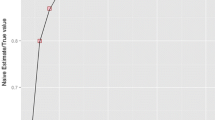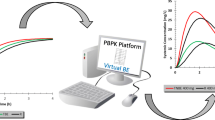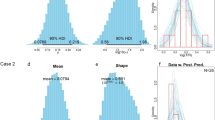Abstract
The influence of random error and elimination rate on estimates of the area under the curve from zero to time infinity (AUC0–INF) was determined in a simulation study using noninfinity measured AUC values (i.e., AUCTM, area to a measured common sampling time, and AUC0-LAST, area to the last measured sampling time). Further, the extent of absorption of generic danazol, baclofen, and oxazepam was determined using measured methods of estimating area under the curve in bioequivalence studies. The noninfinity AUC estimates and their 90% confidence intervals for the difference in product means were compared for each individual drug. Products chosen fulfilled one of the following three criteria: (1) a high “apparent intrasubject variability” and a half-life greater than 8 hr (danazol); (2) a low apparent intrasubject variability and a half-life less than 4 hr (baclofen); and (3) products exhibiting a low apparent intrasubject variability and a half-life greater than 8 hr (oxazepam). For the simulated data, AUCTM performed best when subjects had similar half-lives (i.e., low variability), which results in AUCTM = AUC0–LAST. On the other hand, AUC0–LAST worked best with a high fractional standard deviation (fsd) and a short elimination half-life (i.e., less than 4 hr). The noninfinity 90% confidence intervals for danazol and oxazepam were inconsistent with those observed at AUC0–INF. However, baclofen, which has a short elimination half-life, exhibited good agreement between the noninfinity and the AUC0–INF 90% confidence intervals. However, across all three drug groups, the comparison based upon the area calculated from time zero to the last quantifiable concentration, AUC0–LAST, consistently provided the best approximation of AUC0–INF.
Similar content being viewed by others
REFERENCES
M. Gibaldi and D. Perrier. In Pharmacokinetics, 2nd Ed., Marcel Dekker, New York, 1982.
F. Hatch, K. McKellop, G. Hansen, and T. MacGregor. Relative bioavailability of metaproterenol in humans utilizing a single dose, stable isotope approach. J. Pharm. Sci. 75:886–890 (1986).
M.-L. Aitio, H. Allonen, J. Kanto, and R. Mantyla. The pharmacokinetics of disopyramide and mono-N-dealkyl-disopy-ramide in humans. Int. J. Clin. Pharmacol. Ther. Toxicol. 20:219–226 (1982).
M. Kraml, D. R. Hicks, M. McKean, J. Panagides, and J. Furst. The pharmacokinetics of etodolac in serum and synovial fluid of patients with arthritis. Clin. Pharmacol. Ther. 43:571–576 (1988).
A. T. Tembo, M. R. Hallmark, E. Sakmar, H. G. Bachmann, D. J. Weidler, and J. G. Wagner. Bioavailability of prednisolone tablets. J. Pharmacokinet. Biopharm. 5:257–270 (1977).
A. B. Straughn, G. C. Wood, G. Gursharan, and M. C. Meyer. Bioavailability of seven furosemide tablets in man. Biopharm. Drug Disp. 7:113–120 (1986).
F. Sorgel, J. Hasegawa, E. T. Lin, and R. L. Williams. Oral triamterene disposition. Clin. Pharmacol. Ther. 38:306–312 (1985).
R. K. Ferguson, P. H. Vlasses, J. R. Koplin, G. I. Holmes, P. Huber, J. Demetriades, and W. B. Abrams. Relationship among timolol doses, plasma concentrations and B-adrenoceptor blocking activity. Br. J. Clin. Pharmacol. 14:719–725 (1982).
K. Onoyama, F. Nanishi, S. Okuda, Y. Oh, M. Fujishima, M. Tateno, and T. Omae. Pharmacokinetics of a new angiotensin I converting enzyme inhibitor (delapril) in patients with deteriorated kidney function and in normal control subjects. Clin. Pharmacol. Ther. 43:242–249 (1988).
E. G. Lovering, I. J. McGilveray, I. McMillan, and W. Tostowaryk. Comparative bioavailabilities from truncated blood level curves. J. Pharm. Sci. 64:1521–1524 (1975).
J. G. Wagner. An overview of the analysis and interpretation of bioavailability studies in man. Pharmacology 8:102–117 (1972).
M. Berman and M. Weiss. User's Manual for SAAM, National Institutes of Health, Bethesda, Md., 1974.
W. D. Hooper, G. R. Cannell, and R. G. Dickinson. Sensitive and selective assay of danazol in plasma by high-performance liquid chromatography. J. Chromatogr. 416:347–352 (1987).
G. A. Nygard, L. J. Lovett, G. R. Erdmann, and S. K. W. Khalil. Analysis of danazol in serum using high-performance liquid chromatography. J. Chromatogr. 415:438–444 (1987).
P. M. Harrison, A. M. Tonkin, and A. J. McLean. Determination of 4-amino-3(p-chlorophenyl)butyric acid (baclofen) in plasma by high-performance liquid chromatography. J. Chromatogr. 339:424–428 (1985).
K. Tada, T. Moroji, R. Sekiguchi, H. Motomuta, and T. Noguchi. Liquid-chromatographic assay of diazepam and its major metabolites in serum, and application to pharmacokinetic study of high doses of diazepam in schizophrenics. Clin. Chem. 10:1712–1715 (1985).
K. Yamaoka, T. Nakagawa, and T. Uno. Application of Akaike's information criterion (AIC) in the evaluation of linear pharmacokinetic equations. J. Pharmacokin. Biopharm. 6:165–175 (1978).
G. W. Snedecor and W. C. Cochran. Statistical Methods, Iowa State University Press, Ames, 1976.
D. J. Schuirmann. A comparison of the two one-sided tests procedure and the power approach for assessing the equivalence of average bioavailability. J. Pharmacokin. Biopharm. 15:657–680 (1987).
D. F. Morrison. In Multivariate Statistical Methods, McGraw-Hill, Toronto, Canada, 1967.
R. A. Ronfeld and L. Z. Benet. Interpretation of plasma concentration-time curves after oral dosing. J. Pharm. Sci. 66:178–180 (1977).
Author information
Authors and Affiliations
Rights and permissions
About this article
Cite this article
Martinez, M.N., Jackson, A.J. Suitability of Various Noninfinity Area Under the Plasma Concentration–Time Curve (AUC) Estimates for Use in Bioequivalence Determinations: Relationship to AUC from Zero to Time Infinity (AUCO–INF). Pharm Res 8, 512–517 (1991). https://doi.org/10.1023/A:1015863530888
Issue Date:
DOI: https://doi.org/10.1023/A:1015863530888




